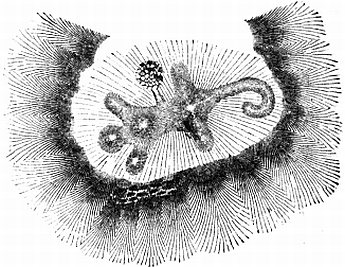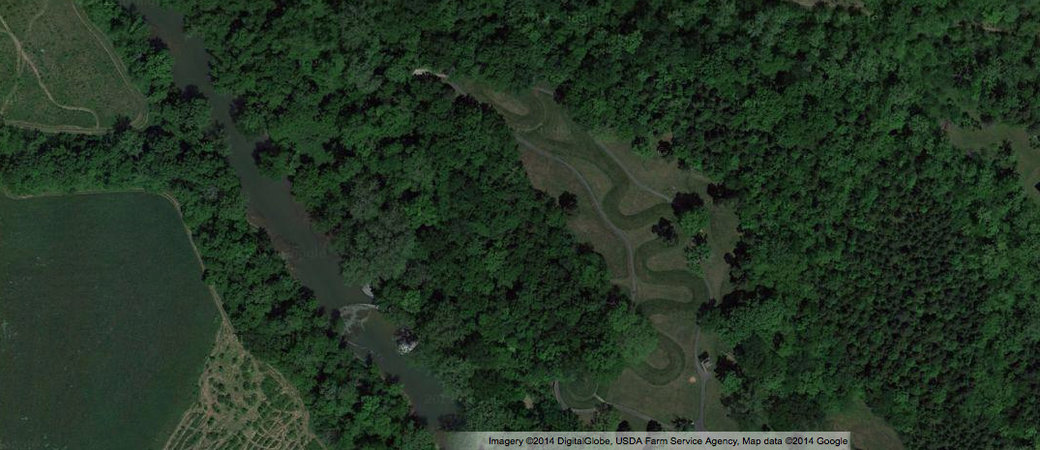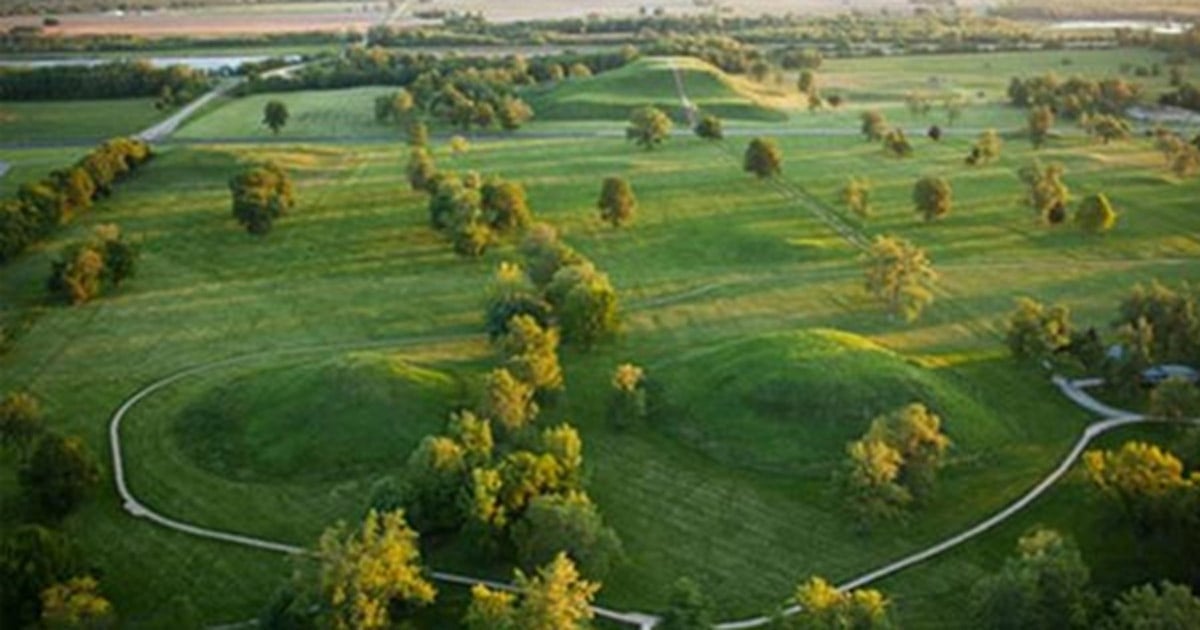Ancient Serpent Mounds, the mystery of the cosmos world order

Source: Ancient Serpent Mounds, the mystery of the cosmos world order by SpaceTrack
Alligator Effigy Mound The Alligator Effigy Mound is an effigy mound in Granville, Ohio, United States. The mound is believed to have been built between AD 800 and 1200 by people of the Fort Ancient culture.The mound was likely a ceremonial site, as it was not used for burials. Located on privately owned land, Alligator Mound is one of two extant effigy mounds known in the present-day state of Ohio, along with Serpent Mound in Adams County, Ohio.It has been listed on the National Register of Historic Places since 1971. Effigy mounds were built more often by ancient indigenous peoples located in the areas of the present-day states of Illinois, Iowa, and Wisconsin than in the Ohio area, and many have survived there. https://en.wikipedia.org/wiki/Alligator_Effigy_Mound
https://en.wikipedia.org/wiki/Alligator_Effigy_Mound


Source: Ancient Serpent Mounds, the mystery of the cosmos world order by SpaceTrack
Alligator Effigy Mound The Alligator Effigy Mound is an effigy mound in Granville, Ohio, United States. The mound is believed to have been built between AD 800 and 1200 by people of the Fort Ancient culture.The mound was likely a ceremonial site, as it was not used for burials. Located on privately owned land, Alligator Mound is one of two extant effigy mounds known in the present-day state of Ohio, along with Serpent Mound in Adams County, Ohio.It has been listed on the National Register of Historic Places since 1971. Effigy mounds were built more often by ancient indigenous peoples located in the areas of the present-day states of Illinois, Iowa, and Wisconsin than in the Ohio area, and many have survived there.
 https://en.wikipedia.org/wiki/Alligator_Effigy_Mound
https://en.wikipedia.org/wiki/Alligator_Effigy_Mound
- Public Domain
- File:Alligator Effigy Mound from the north.jpg
- Created: 17 March 2011
- Location: 40° 4′ 12″ N, 82° 30′ 4″ W
View from the north of the Alligator Effigy Mound, an effigy mound located inside a traffic circle formed by Bryn Du Drive on the eastern side of Granville, Ohio, United States. Now thought to be a representation of an underwater panther, it appears to have been built by the Fort Ancient culture. As an important archaeological site, it is listed on the National Register of Historic Places.
- National Park Service (2008-04-15). "National Register Information System". National Register of Historic Places. National Park Service.
- ^ Jump up to:a b c d "Alligator Mound". Ohio Historical Society. Retrieved 2008-10-26.
- ^ Jump up to:a b "The Licking County Historical Society - Alligator Mound". The Licking County Historical Society. Archived from the original on 2008-08-04. Retrieved 2008-10-26.
- ^ Jump up to:a b c d Ephraim George Squier; Edwin Hamilton Davis (1848). Ancient Monuments of the Mississippi Valley. Smithsonian Institution. pp. 217–221.
- Jump up^ Lepper, Brad; Frolking, Tod A. (2003). "Alligator Mound: Geoarchaeological and Iconographical Interpretations of a Late Prehistoric Effigy Mound in Central Ohio, USA". Cambridge Archaeological Journal. 13 (2): 147–167. doi:10.1017/S0959774303000106.
Serpent Mound

The Great Serpent Mound in rural, southwestern Ohio is the largest serpent effigy in the world. Numerous mounds were made by the ancient Native American cultures that flourished along the fertile valleys of the Mississippi, Ohio, Illinois, and Missouri Rivers a thousand years ago, though many were destroyed as farms spread across this region during the modern era. They invite us to contemplate the rich spiritual beliefs of the ancient Native American cultures that created them.

The Great Serpent Mound measures approximately 1,300 feet in length and ranges from one to three feet in height. The complex mound is both architectural and sculptural and was erected by settled peoples who cultivated maize, beans and squash and who maintained a stratified society with an organized labor force, but left no written records. Let’s take a look at both aerial and close-up views that can help us understand the mound in relationship to its site and the possible intentions of its makers.
 A digital GIS map of Ohio's Great Serpent Mound, created by Timothy A. Price and Nichole I. Stump in March 2002
A digital GIS map of Ohio's Great Serpent Mound, created by Timothy A. Price and Nichole I. Stump in March 2002


 Last week, I heard Maya Lin speak at the university where I work. Her lecture was uncannily appropriate, since I had planned for my students to learn about Lin last week (before realizing that she was coming to speak). Minutes after the lecture began, I had two distinct impressions: 1) Lin is extremely tired of speaking about the Vietnam War Memorial and 2) Lin has a lot of flexibility in her career, since she established fame and recognition so early in life. Really, because Lin already has public attention and a fan base, she can create whatever she wants; she isn't like many other contemporary artists, who seem to feel the need to be shocking or controversial in order to get attention.
One of my favorite parts of the lecture was when Lin discussed her ideas behind her earth art Eleven Minute Line (2004). This squiggly line is 1600 feet long and 12 feet high. And here's the awesome part: it's located in a cow pasture in Sweden. The first time I saw Lin's piece, it immediately reminded me of the Serpent Mound (c. 1070 AD) in Adams County, Ohio (shown below). The Serpent Mound is the largest effigy structure in the United States, and it is thought to have been built by the the Fort Ancient people. (It was originally thought that the structure was built in prehistoric times, but carbon dating of the mound revealed a much later date.)
My suspicions regarding the connection between Eleven Minute Line and the Serpent Mound were confirmed during Lin's lecture. The artist is from Ohio, and she has always been struck with the story of the Serpent Mound. When Europeans came to America and discovered the Serpent Mound, they concluded that an earlier group of Europeans must have made the structure and then traveled back to the Old World. Basically, these European explorers could not conceive that Native Americans could have built something so complex and monumental. Lin decided add a subtle element of irony with Eleven Minute Line by turning the tables a bit: she brought a design that was inspired from the New World back to the Old World (i.e. Sweden).
http://albertis-window.blogspot.com/2010/04/maya-lin-and-eleven-minute-line.html
Adena Culture
Last week, I heard Maya Lin speak at the university where I work. Her lecture was uncannily appropriate, since I had planned for my students to learn about Lin last week (before realizing that she was coming to speak). Minutes after the lecture began, I had two distinct impressions: 1) Lin is extremely tired of speaking about the Vietnam War Memorial and 2) Lin has a lot of flexibility in her career, since she established fame and recognition so early in life. Really, because Lin already has public attention and a fan base, she can create whatever she wants; she isn't like many other contemporary artists, who seem to feel the need to be shocking or controversial in order to get attention.
One of my favorite parts of the lecture was when Lin discussed her ideas behind her earth art Eleven Minute Line (2004). This squiggly line is 1600 feet long and 12 feet high. And here's the awesome part: it's located in a cow pasture in Sweden. The first time I saw Lin's piece, it immediately reminded me of the Serpent Mound (c. 1070 AD) in Adams County, Ohio (shown below). The Serpent Mound is the largest effigy structure in the United States, and it is thought to have been built by the the Fort Ancient people. (It was originally thought that the structure was built in prehistoric times, but carbon dating of the mound revealed a much later date.)
My suspicions regarding the connection between Eleven Minute Line and the Serpent Mound were confirmed during Lin's lecture. The artist is from Ohio, and she has always been struck with the story of the Serpent Mound. When Europeans came to America and discovered the Serpent Mound, they concluded that an earlier group of Europeans must have made the structure and then traveled back to the Old World. Basically, these European explorers could not conceive that Native Americans could have built something so complex and monumental. Lin decided add a subtle element of irony with Eleven Minute Line by turning the tables a bit: she brought a design that was inspired from the New World back to the Old World (i.e. Sweden).
http://albertis-window.blogspot.com/2010/04/maya-lin-and-eleven-minute-line.html
Adena Culture
Painting from the Ancient Ohio art series depicting an Early Woodland/Adena (800 BC - AD 1) gathering at a ceremonial earthwork in the Hocking River Valley.
http://www.ohiohistorycentral.org/w/Adena_Culture The "Adena culture" is an archaeological term used to refer to a pre-contact American Indian culture that lived in Kentucky, southeastern Indiana, southwestern Pennsylvania, and most prominently in the Scioto River and Hocking Valleys in southern Ohio, and the Kanawha Valley near Charleston, West Virginia, during the Early Woodland Period (ca. 2,800-2,000 BP). The name “Adena” originates from the estate of Ohio Governor Thomas Worthington, about one and a half miles northwest of Chillicothe, Ohio, in Ross County, which he called “Adena,” which Worthington’s diary claims comes from a Hebrew name that “was given to places for the delightfulness of their situations.” Worthington’s estate was the home of a 26 foot tall ancient burial mound, hence the “Adena Mound” and “Adena culture.”
- Sheboygan Indian Mound Park in Sheboygan, Wisconsin
- Beattie Park Mound Group in Rockford, Illinois
- Effigy Mounds National Monument, Iowa
- Indian Mound Park in Dauphin Island, Alabama
- Indian Mound Park in Ortona, Florida
- Indian Mounds Park in Quincy, Illinois
- Indian Mounds Park in Saint Paul, Minnesota
- Indian Mounds Park in Whitewater, Wisconsin
- Indian Temple Mound and Museum in Fort Walton Beach, Florida
- Newark Earthworks in Newark, Ohio
- Ormond Mound in Ormond Beach, Florida
- Serpent Mound in Adams County, Ohio


The Moundbuilders North America’s Little-known Native Architects
The prehistoric people of Central and South America are known worldwide for their fantastic architectural and cultural achievements. However, North American natives are not known as great builders. But that does not mean they didn’t build. It also doesn’t mean that they didn’t have civilizations. Many cultures of pre-European-contact North America did settle down in cities and practice agriculture and have sophisticated religions and ceremonial sites. Some even made copper and iron artifacts, and metallurgy has long been considered a sign of advanced accomplishment.
But what is little known is that there were also the moundbuilders in what is now the United States. People in many regions of the prehistoric U.S. built earthen mounds, some of which reached 100 feet (30.48 meters). They built them over the course of 5,000 years, archaeologists have estimated.

Earth’s Milky Way Galaxy over Mound A at Poverty Point, Louisiana, which was built circa 1400 AD. ( Photo by Jenny Ellerbe ) Penn Museum of the University of Pennsylvania Museum of Archaeology and Anthropology in Philadelphia is opening a show later this month called Moundbuilders: Ancient Architects of North America. A press release from the university states: Earthen mounds—including some of the earliest monumental constructions in the world— have been engineered by diverse Native American groups over millennia. Yet the sizes, shapes, and purposes of mounds have varied greatly over time and geographical distance. Mounds have played and continue to play important roles in the religious, social, and political lives of Native American people. Some have been burial mounds; others have been centers of trade and community gatherings; still others have served as the foundations for important buildings or activities. Archaeologists, fascinated by the extraordinary engineering feats of the moundbuilders, have been excavating and mapping this tradition since the 18 th century. To date, many thousands of mounds have been discovered, from those at Cahokia, the massive Native American city outside Saint Louis, Missouri, to smaller mound sites like Smith Creek in Mississippi where the Penn Museum currently excavates. Over time, many mounds have been destroyed by farmers or leveled due to urban expansion; many more are believed to exist, not yet discovered.
The exhibition chronologically explores the changing construction methods and purposes of the Native American mounds. It begins with the earliest known mounds of about 3700 BC. These were built in the Lower Mississippi Valley by small groups of hunter-gatherers. They accomplished these feats without metal tools. Archaeologists believe they built up the mounds by moving dirt to the sites in baskets. As long ago as 1400 BC, at the Poverty Point site in the same region, in Louisiana, there were mounds so large they would have required thousands of workers. At this site researchers have found stone objects that provide evidence of specialized artisans and trade routes over which materials were transported.

- Rare Moon Alignment Tonight at Amerindian site, at Largest Geometric Earthworks
- Ancient Earthworks of North America suggest pre-Columbian European contact
- Wickliffe Mounds: A Pre-Columbian Native American Site

Earth’s Milky Way Galaxy over Mound A at Poverty Point, Louisiana, which was built circa 1400 AD. ( Photo by Jenny Ellerbe ) Penn Museum of the University of Pennsylvania Museum of Archaeology and Anthropology in Philadelphia is opening a show later this month called Moundbuilders: Ancient Architects of North America. A press release from the university states: Earthen mounds—including some of the earliest monumental constructions in the world— have been engineered by diverse Native American groups over millennia. Yet the sizes, shapes, and purposes of mounds have varied greatly over time and geographical distance. Mounds have played and continue to play important roles in the religious, social, and political lives of Native American people. Some have been burial mounds; others have been centers of trade and community gatherings; still others have served as the foundations for important buildings or activities. Archaeologists, fascinated by the extraordinary engineering feats of the moundbuilders, have been excavating and mapping this tradition since the 18 th century. To date, many thousands of mounds have been discovered, from those at Cahokia, the massive Native American city outside Saint Louis, Missouri, to smaller mound sites like Smith Creek in Mississippi where the Penn Museum currently excavates. Over time, many mounds have been destroyed by farmers or leveled due to urban expansion; many more are believed to exist, not yet discovered.
The exhibition chronologically explores the changing construction methods and purposes of the Native American mounds. It begins with the earliest known mounds of about 3700 BC. These were built in the Lower Mississippi Valley by small groups of hunter-gatherers. They accomplished these feats without metal tools. Archaeologists believe they built up the mounds by moving dirt to the sites in baskets. As long ago as 1400 BC, at the Poverty Point site in the same region, in Louisiana, there were mounds so large they would have required thousands of workers. At this site researchers have found stone objects that provide evidence of specialized artisans and trade routes over which materials were transported.

This is Mound A or the Great Temple Mound at Etowah Mounds near Cartersville Georgia. It was built around 1250 AD. Many of these mound centers dotted the eastern landscape before Europeans arrived. ( Photo by Tom Patton )





Комментариев нет:
Отправить комментарий